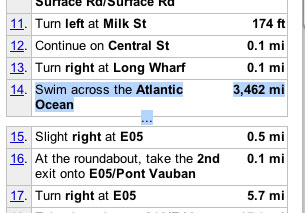The question that puzzles anyone visiting Ireland regularly — as I do — is this: what’s sustaining the current economic boom? The answer is — as even a cursory inspection of the land- and townscape reveals — property speculation and construction. It’s also clear that it cannot go on; there are only so many hotels that a small country can fill.
Nut now there’s some evidence that the chickens may be coming home to roost. For example, this piece in Thursday’s Irish Times by the paper’s Economics editor:
Signals of a slowdown in the economy emerged yesterday with the release of figures which showed a drop for the first time in new house starts and a slide in exports.
The number of new houses built in the last quarter of 2006 fell for the first time in 10 years, according to figures released by the Central Statistics Office (CSO). Separate figures showed that the economy’s export performance worsened severely in the same period.
Minister for Finance Brian Cowen warned that risks to the economy were increasing while business group Ibec described the export figures for the last three months of 2006 as “dismal”.
However, Mr Cowen welcomed the strong overall growth in the economy last year, the highest since 2002. He said the economic activity had been buoyant. But he cautioned: “Despite the size, strength and length of our economic success, we must not take that success for granted.”
Gross Domestic Product (GDP) – the level of output in the economy in a given period – grew by 6 per cent last year. The full year out-turn is stronger than December’s Government estimate of 5.4 per cent, but growth slowed in the final quarter to 5 per cent,
That is below the Government’s projection of 5.3 per cent growth this year.
While Government forecasts see the economy relying on more domestic demand next year, the sharp deterioration in external trade suggests this trend may be more significant than expected.
Final quarter net exports – exports of goods and services less imports of goods and services – fell annually by 10.2 per cent, a significantly worse outturn than the 2.8 per cent growth that was recorded for 2006 as a whole.
Government forecasts are for a more modest 2.3 per cent fall in net exports next year.
Although full-year net export growth was positive, a breakdown of exports reveals that goods exports rose by just 0.5 per cent.
The number of new houses built in the final quarter was 1.7 per cent, down on the same period of 2005. It compared to 2.9 per cent growth for the year as a whole. Data on planning permissions, also updated yesterday, suggest this trend is set to continue for some time.
Approvals of new dwellings in the final quarter of 2006 were 21.4 per cent lower than the same period of 2005, while the number of approved apartments was 30.4 per cent lower.
Pointing to the slowdown in the housing market, Ibec chief economist David Croughan said it was becoming more urgent for the economy to regain competitiveness if it was to compensate for a declining construction sector. “These figures contain no comfort,” he said.
Commenting on this, Maria Farrell writes:
Aside from the property bubble, Irish economic growth has been export-led through foreign direct investment by mainly US firms. The attraction is of our English-speaking and educated workforce, EU-funded infrastructure and access to European markets. But with property prices in Dublin rising 10-15% year on year for much of the last decade, the cost of labour has risen. A sudden and unexpected drop of 10% in exports indicates that something may be seriously wrong. We need to ask why, and figure out what, if anything, we can do about it.
However, the government says hopefully that growth this year will be driven by domestic demand. But how can an export-based economy sustain sufficient domestic demand for more than months at a time? Maybe the promises and give aways of an election year will fuel our faltering economy for another while, or maybe we’re already running on fumes.
The whole country has lost sight of lost sight of the fact that house building and buying are not the keys to economic and financial success, but merely indicators of it. Our economy is distorted, and so are our politics. The establishment generation (those forty and fifty-somethings) have done very well and have the most to lose. Much of our political debate in the last few months has focused on whether and how to reduce stamp duty on house purchases, i.e. how to keep the property boom going by ensuring stamp duty reductions don’t form a simple transfer from buyers to sellers. The real question is; are we fighting an election on spending promises when there won’t be much money left to spend in a year or two? One commentator said recently that this is an election to lose. He may be right.
The generation I worry about are the twenty somethings. They’ve never known a recession, never known a life without part-time jobs and disposable income, never known Northern Ireland before the peace process. They haven’t known hard times. It’s not all doom and gloom; GDP is pretty stable, and our economy is still growing by 5-6% a year. Hard times may not be coming, but straitened ones surely are.
She’s right. Ireland doesn’t have enough indigenous resources or demand to sustain the kind of economy to which my fellow-countrymen and women have become accustomed. Once the construction bubble is punctured, there’s not much left — except tourism, services and agriculture.



